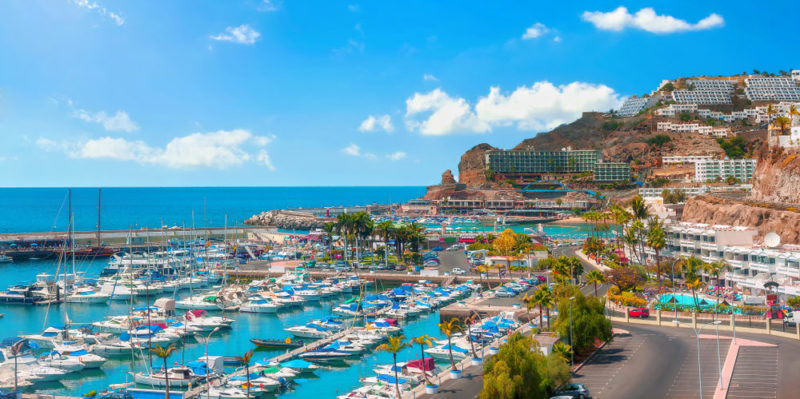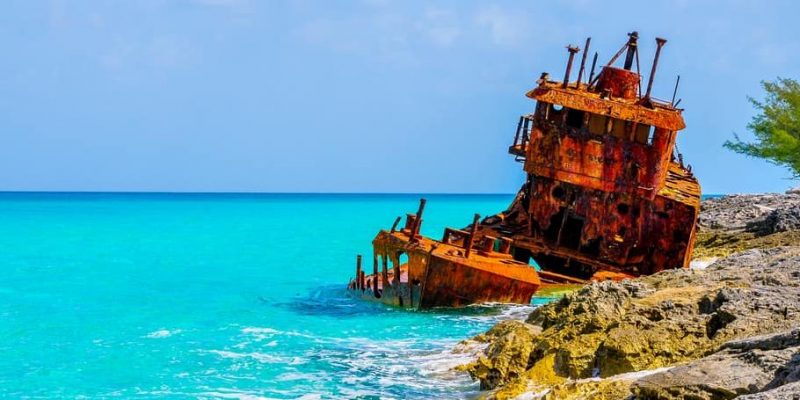We explain what the Atlantic Ocean is, the countries that surround it and how much it extends. Also, what are its characteristics, islands and more.
What is the Atlantic Ocean?
The Atlantic Ocean is the body of salty water that separates the American continent from Europe and Africa . It was formed 200 million years ago after the geological separation of the supercontinent Pangea. It is the youngest of the world's oceans .
Its name comes from the Greek deity Atlas, the titan who holds the world on his back. The ancient Greeks thought that the world ended at the Pillars of Hercules, which mark the end of the Mediterranean Sea , and they assumed the Atlantic Ocean as a gigantic river that circled the world.
For centuries the idea that this ocean marked the end of the known world reigned in Europe , Asia and Africa . But in 1492 the Genoese navigator Christopher Columbus crossed its waters , in search of a trade route to China , and ran into the American continent .
Later, during the time of American colonization , the Atlantic was often crossed from Europe and from Africa . The latter due to the trade of slaves African Caribbean plantations to feed at the time.
Today the Atlantic is one of the most commercially active oceans in the world . It is of vital economic importance for the exchange between the so-called "Old" and "New" continents (Europe and America , respectively).
The oil, fish, tourist and commercial exploitation of this Ocean is one of the largest on the planet .
Where is the Atlantic Ocean located?

The Atlantic is located between the continents of America, Africa and Europe .
To the west it borders the Caribbean Sea , the Gulf of Mexico, the Río de la Plata, Tierra del Fuego, Cape Horn and the Strait of Magellan.
To the East it borders the European coasts , the Mediterranean Sea, the Irish and Scottish Sea, the North Sea, the Bristol Channel, the English Channel, the Bay of Biscay, the Gulf of Guinea.
To the north, it borders the Greenland Sea, the Norwegian Sea and the Davis Strait, and to the south with the Antarctic continent .
The Atlantic Ocean is divided into two regions by the equator : the North Atlantic and the South Atlantic. Many of its surrounding seas are considered separate bodies of water , although oceanographically they are part of the same Atlantic mass.
Countries surrounding the Atlantic Ocean
- In America. Argentina , Bahamas, Brazil , Canada, Cuba, Puerto Rico, Dominican Republic, United States, Guyana, French Guyana, Haiti, Suriname, Trinidad and Tobago, Uruguay , Venezuela and other countries of the Caribbean Sea and the Gulf of Mexico: Antigua and Barbuda , Barbados, Belize, Colombia, Costa Rica, Dominica, Grenada, Guatemala , Honduras, Jamaica, Mexico , Nicaragua , Panama, Saint Kitts and Nevis, and Saint Vincent and the Grenadines.
- In Africa. South Africa, Angola, Benin, Cameroon, Cape Verde, Ivory Coast, Ghana, Gambia, Guinea, Gabon, Guinea-Bissau, Equatorial Guinea, Liberia, Morocco, Mauritania, Namibia, Nigeria, Republic of the Congo, Democratic Republic of the Congo, Santo Tomé and Principe, Senegal, Sierra Leone, Togo and other Mediterranean African countries: Algeria, Egypt, Libya and Tunisia.
- In Europe. Spain , France , United Kingdom , Portugal, Ireland, Iceland, Norway, and other countries of the Baltic Sea: Germany , Belgium, Denmark, Estonia, Finland, Sweden, Latvia, Lithuania, Netherlands, Poland, Russia, and other countries of the sea Mediterranean: Albania, Bosnia and Herzegovina, Cyprus, Northern Cyprus, Croatia, Slovenia, Greece , Italy , Malta, Monaco, Montenegro.
- In Asia. Across the Mediterranean: Lebanon, Israel, Syria, Turkey, Palestine, and other countries with coasts on the Black Sea: Abkhazia, Bulgaria, Georgia, Romania, Ukraine.
Atlantic Ocean Extension
 The Atlantic Ocean is the second largest on the planet , occupying 20% of its total area and 26% of the submerged territories. It is shaped like the letter "S". Its waters cover an area of 81,760,000 km 2 without counting the adjacent seas (106.5 million in total).
The Atlantic Ocean is the second largest on the planet , occupying 20% of its total area and 26% of the submerged territories. It is shaped like the letter "S". Its waters cover an area of 81,760,000 km 2 without counting the adjacent seas (106.5 million in total).It reaches its maximum width of 11,800 km from the Gulf of Mexico to Georgia, a European country located on the shores of the Black Sea. This area contains about 354.7 million cubic kilometers of water, counting the adjacent seas.
Density and temperature of the Atlantic Ocean
Like other oceans and seas, its density depends on the degree of salinity of its waters , which on average has 36 grams of salt per liter of water.Temperatures also play a role , which tend to be lower in regions near the poles. Its highest temperatures are in the tropical and intertropical region.
Atlantic Ocean and Pacific Ocean
 The Atlantic and the Pacific meet in only two places:
The Atlantic and the Pacific meet in only two places:
- In the artificial passage called the Panama Canal , located in this Caribbean country and consisting of a system of locks.
- Through the Strait of Magellan and the Drake Passage, in southern South America , between this continent and the Antarctic .
Islands of the Atlantic Ocean
 The Atlantic Ocean has a significant number of islands, grouped into:
The Atlantic Ocean has a significant number of islands, grouped into:
- The Svalbard Archipelago, in the Norwegian Sea.
- Islands of the Scandinavian peninsula off the Norwegian and Swedish coasts.
- Baltic Sea islands, starting in the Danish Straits.
- Islands of the continental European coastline, from Jutland to the English Channel.
- British Isles, among which are the United Kingdom and Ireland.
- Islands on the Atlantic coast of France, Spain and Portugal up to the Strait of Gibraltar.
- Mediterranean islands such as Sicily, Sardinia, Cyprus, Corsica, Mallorca, Crete, Rhodes, Lesbos, etc.
- Islands on the African coast, such as the Canaries or the Azores.
- South American islands, like Trinidad and Tobago.
- Islands of the Caribbean Sea, such as Isla Margarita, Hispaniola, Cuba, Puerto Rico, etc.
- Islands in the Gulf of Mexico, such as Isla Pérez or the Florida Keys.
Atlantic Ocean Pollution
The Atlantic is the recipient of polluting emissions from America , Africa and Europe. In that sense, it is an environment bombarded by industrial waste, sewage and other pollutants.Special mention should be made of the North Atlantic Garbage Patch : an area highly polluted with plastics and solid waste that floats trapped in the North Atlantic Giro, one of its main currents. This spot is around the parallel 32 ° N, and extends between the parallels 22 ° N to 38 ° N.
The Bermuda Triangle
 Located in the Atlantic, this region in the shape of an equilateral triangle between the islands of Bermuda, Puerto Rico and the coast of Florida in the United States is famous for its dangerous navigation and even overflight.
Located in the Atlantic, this region in the shape of an equilateral triangle between the islands of Bermuda, Puerto Rico and the coast of Florida in the United States is famous for its dangerous navigation and even overflight.Numerous shipwrecks and air accidents attributed to unknown forces in the area are attributed to him.
There are numerous popular theories about it, ranging from magnetic confluences to extraterrestrial presence , but nothing is scientifically proven to date.
NATO
 These are the acronyms for the North Atlantic Treaty Organization , also called the North Atlantic Alliance.
These are the acronyms for the North Atlantic Treaty Organization , also called the North Atlantic Alliance.It is an international alliance of countries in the North Atlantic region , of a military and strategic nature. The member countries commit to a mutual defense in case of being attacked by any external power.
This organization is based in Brussels, Belgium and was founded in 1949 with the signing of the aforementioned treaty.
Atlantis
Another myth of the Atlantic Ocean is that of Atlantis, a submerged continent centuries ago . According to this belief, there was a powerful ancient civilization, which was located in the heart of the North Atlantic.The Atlanteans, inhabitants of this mythical continent, appear in different texts of classical antiquity . They are even mentioned by Plato .
They are credited with the military and commercial dominance of western Europe and North Africa. But, according to legend , they were stopped by the Athenians. This myth has endured through the centuries, without there being clear indications of any kind of historical or scientific verification in this regard.
The above content published at Collaborative Research Group is for informational and educational purposes only and has been developed by referring reliable sources and recommendations from technology experts. We do not have any contact with official entities nor do we intend to replace the information that they emit.
Abubakr Conner brings a diverse skill set to our team, and covers everything from analysis to the culture of food and drink. He Believes: "Education is the most powerful weapon that exists to change the world." .
Leave a reply
Your email address will not be published. Required fields are marked *Recent post

Sport: What Is It, Types, Risks, Features, Characteristics and Examples

Dogs: Emergence, Features, Characteristics, Feeding and Breeds

Story: Definition, Elements, Structure, Features and Characteristics

